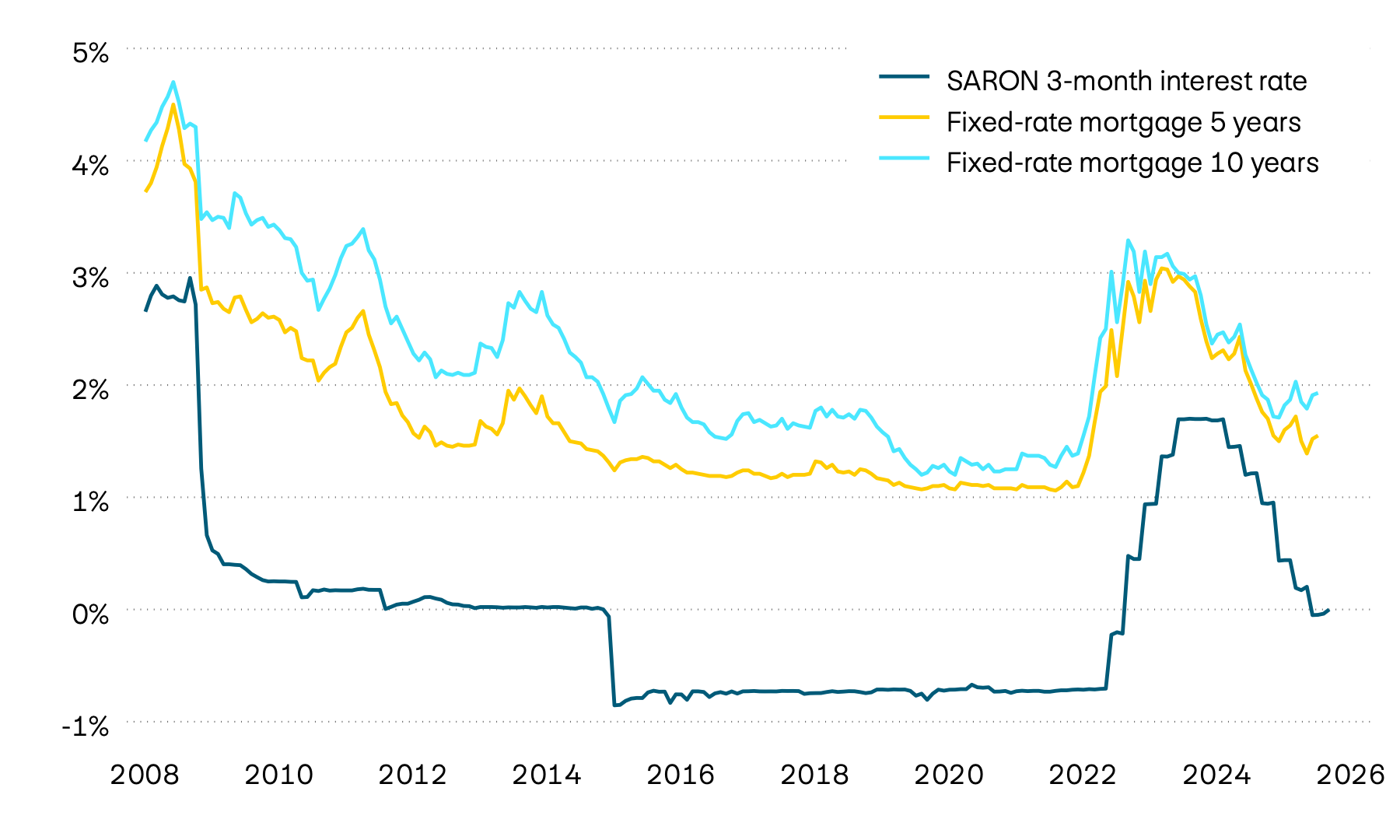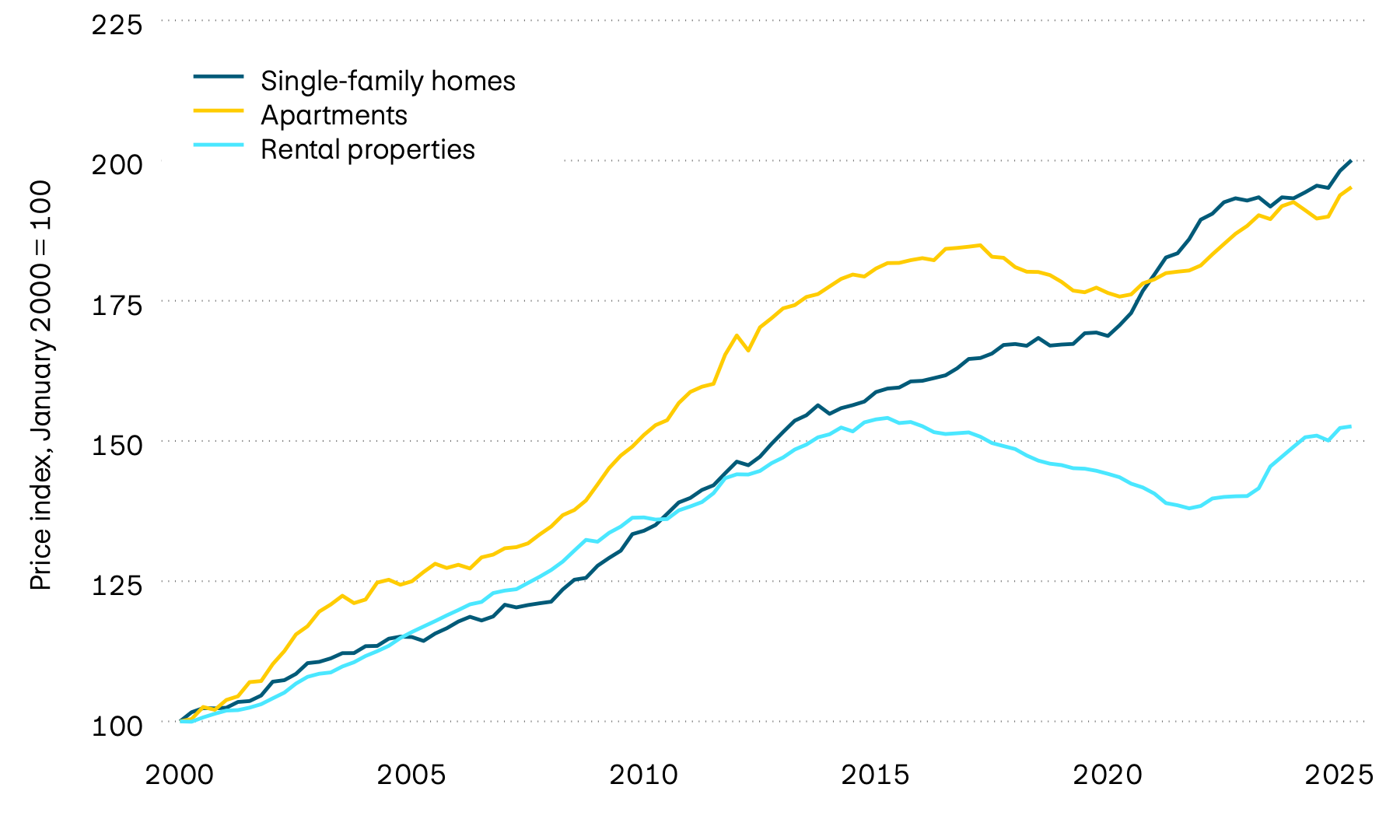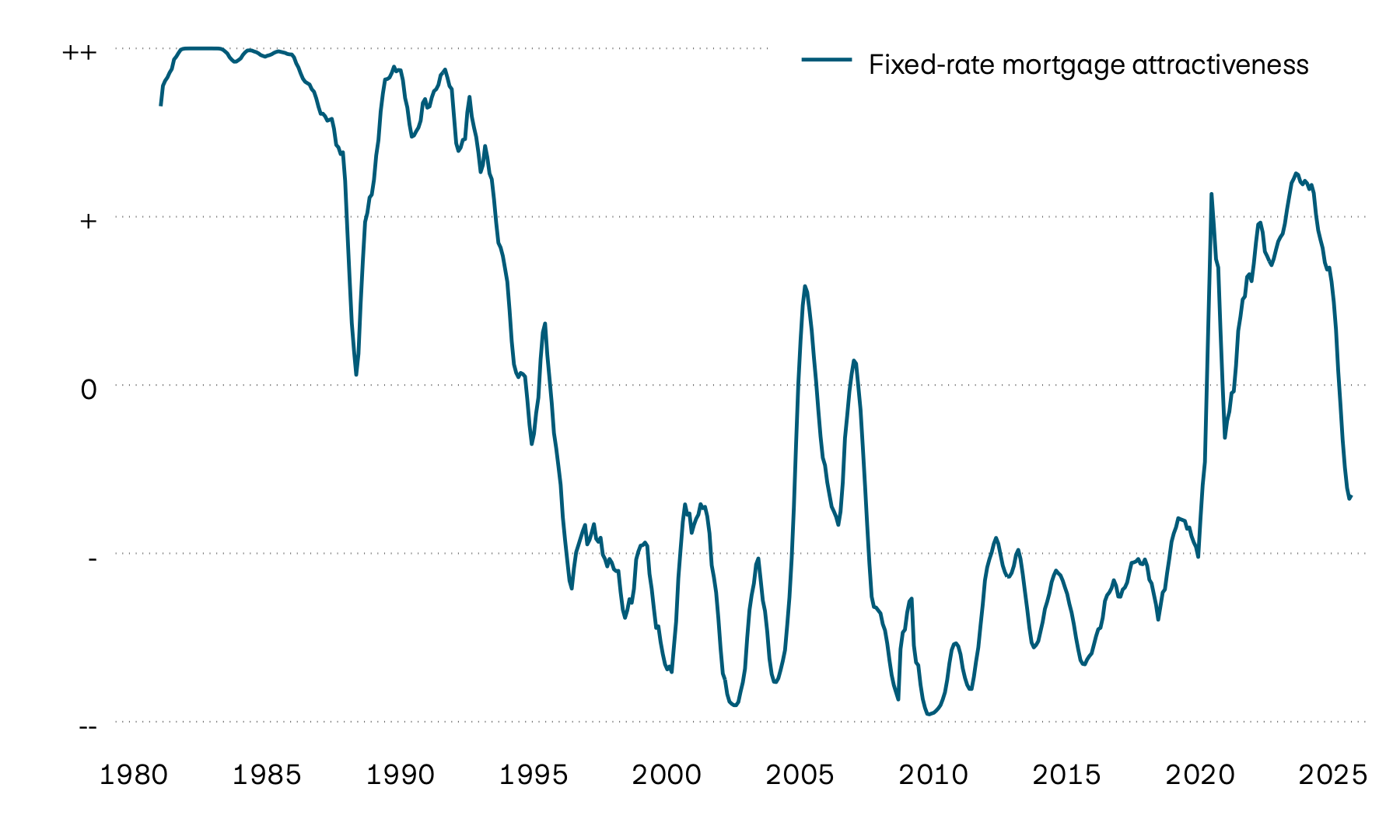
Swiss mortgage interest rate forecast
Our assessment of the mortgage market
You are here:
How will mortgage interest rates develop over the coming months? Find out how our experts view developments on the mortgage and real estate markets.
Status as at: 25.09.2025
Editorial deadline: 25.09.2025
The zero interest rate policy of the Swiss National Bank (SNB) makes Saron mortgages particularly attractive at the moment. Fixed-rate mortgages also offer attractive financing options as both the SNB policy rate and longer-term capital market interest rates are at a low level.
Current economic situation in Switzerland
The Swiss economy has remained solid so far this year in a difficult environment. It rose sharply in the first quarter in particular. Besides strong domestic demand, this was primarily due to orders to the USA being brought forward to pre-empt the tariffs. The pace of growth has slowed significantly since the start of the second quarter. However, a slump has been avoided so far.
Our interest rate forecast at a glance
| Forecast for | 3 months | 6 months | 12 months |
|---|---|---|---|
| Forecast for Saron |
3 months |
6 months |
12 months |
| Forecast for 5-year fixed-rate mortgae |
3 months |
6 months |
12 months |
| Forecast for 7-year fixed-rate mortgage |
3 months |
6 months |
12 months |
| Forecast for 10-year fixed-rate mortgage |
3 months |
6 months |
12 months |
Pressure on the Swiss National Bank (SNB) to cut the policy rate again and, in turn, to introduce negative interest rates is likely to increase over the course of next year. This is due to expected economic weakness and the risk that inflation could fall below the zero percent threshold. Downward adjustments to administered prices, such as electricity, are anticipated at the start of the new year. The reduction in the reference interest rate is expected to reduce the pressure on rent prices. However, owners would not benefit from a further reduction in the policy rate as Saron mortgages usually have a floor of 0 percent. If the Saron falls below this, the interest payable remains unchanged. Medium- and long-term mortgages are also expected to move sideways, given the already very low level. The recent decision to abolish the taxation of imputed rental value is unlikely to have much impact, even though medium-term demand for mortgages may fall slightly as a result.
In 2022, interest rates on fixed-rate mortgages climbed to just over 3 percent due to monetary policy measures to combat high inflation. They did fall sharply after the central bank’s change of course last year and briefly stood at well below 2 percent. However, there has since been slight upward pressure again. This development is partly due to more restrained bank lending. The decision to abolish the taxation of imputed rental value is unlikely to have much impact. We anticipate that the majority of fixed-rate mortgages will trend sideways over the next 12 months. Conversely, we expect a further decline in the 3-month Saron as we expect an additional reduction in policy rates, not at the next assessment on 11 December 2025, but only in March 2026.
In percent

Single-family homes and condominiums
Real estate prices climbed again in the past quarter, with single-family homes and owner-occupied apartments making particularly strong gains. This is mainly due to persistently low capital market interest rates in Switzerland, which are fuelling demand for residential property, while supply remains scarce. By contrast, the positive price momentum on the rental housing market has weakened slightly. This subdued trend looks set to continue in the coming months, particularly as the reference interest rate was recently cut for the second time this year.
Price index, January 2000 = 100

Interested in real estate as an investment opportunity? In our Investment compass under “Market overview”, you will find an analysis of the current situation on the Swiss real estate market.
What our experts say
“With the zero interest rate policy, Saron mortgages and fixed-rate mortgages remain attractive. Real estate prices rose again in the past quarter.
Receive our assessment directly by e-mail after each SNB decision.

Fixed-rate mortgage or Saron mortgage?
Which is the right mortgage for me?

Gain an overview of the conditions for the fixed-rate mortgage and the Saron mortgage with our mortgage comparison.
| Indicators | Q3 2024 | Q4 2024 | Q1 2025 | 2024 | 2025 | 2026 |
|---|---|---|---|---|---|---|
| Indicators GDP growth |
Q3 2024 1,6% |
Q4 2024 1,8% |
Q1 2025 1,2% |
2024 1,3% |
2025 1,0% |
2026 1,1% |
| Indicators Inflation |
Q3 2024 0,7% |
Q4 2024 0,4% |
Q1 2025 0,0% |
2024 1,1% |
2025 0,2% |
2026 0,6% |
| Indicators Unemployment |
Q3 2024 2,6% |
Q4 2024 2,9% |
Q1 2025 2,7% |
2024 2,5% |
2025 3,1% |
2026 2,7% |
| Indicators Net immigration |
Q3 2024 25‘000 |
Q4 2024 23‘000 |
Q1 2025 16‘000 |
2024 90‘000 |
2025 80‘000 |
2026 70‘000 |
| Indicators EUR/CHF exchange rate |
Q3 2024 0,94 |
Q4 2024 0,96 |
Q1 2025 0,94 |
2024 0,95 |
2025 0,94 |
2026 0,92 |
Source: Bloomberg, Allfunds Tech Solutions, BfS
-
Forecasting is a well-founded assessment, not a certainty. Whether now is the right time for you very much depends on your personal risk appetite, your financial situation and your individual needs.
If interest rates are falling: if you expect interest rates to continue to fall, a Saron mortgage may be an attractive option to benefit from the cuts, depending on the interest rate level.
If interest rates are rising: if you are expecting an interest rate rise or budget security is very important for you, it may be a good idea to fix the conditions over the long term with a fixed-rate mortgage.
Our specialists would be happy to help you find the right strategy.
-
The SNB policy rate can affect mortgage interest rates. This usually happens quickly with variable models such as the Saron mortgage, as these are based directly on short-term money market rates. Fixed-rate mortgages, however, are driven more by long-term capital market interest rates (swap rates) which to some extent already take into account anticipated future monetary policy and inflation. If a policy rate change is expected by the markets, its effect on fixed-rate mortgages could in many cases already be reflected in the interest rates beforehand.
-
Choosing the term is a strategic decision. Long terms (7–10 years or more) provide you with interest rate security over a long period of time, but are often slightly more expensive. Shorter terms (2–5 years) are usually cheaper, but require you to address the interest rate situation again sooner. Splitting is a popular strategy: you can split your mortgage into several tranches with different terms if required. This spreads the interest rate risk and avoids having to renew the total amount at once at potentially unfavourable conditions.
-
Our interest rate forecasts are produced by our economists on the basis of in-depth analyses of the global and national economic situation, inflation trends and the monetary policy of central banks. They represent a likely development. However, ongoing or unforeseen economic or political events can have an impact on interest rate developments at any time. Forecasts should therefore always be seen as a guide and not a guarantee.
-
Prices are mainly influenced by supply and demand. Low mortgage interest rates can generally boost demand for home ownership, as financing costs fall. This can lead to stable or rising real estate prices. Conversely, if interest rates rise sharply, this can dampen demand – but it doesn’t have to, especially if supply remains tight. Political decisions on mortgage lending can also influence demand for residential property and therefore property prices.
-
Yes, that is possible. With a forward mortgage, you can secure the current interest rates today – even if your existing mortgage is not set to expire for several months (e.g. in six, 12 or up to 18 months). Depending on the lead time, requested term and market situation, an interest rate premium (forward premium) may be incurred. In return you will be protected against any interest rate rises until your current mortgage expires. Please contact us for a non-binding quotation.
This document and the information and statements it contains are for information purposes only and do not constitute either an invitation to tender, a solicitation, an offer or a recommendation to buy the related products. The customer or third parties are responsible for their own actions and bear sole responsibility for compliance with legal and regulatory provisions and guidelines. PostFinance has used sources considered reliable and credible. However, PostFinance cannot guarantee that this information is correct, accurate, reliable, up to date or complete and excludes any liability to the extent permitted by law. Information on interest rates and prices is up to date, but the actual development may deviate from these forecasts at any time. The content of this document is based on various assumptions. This means that the information and opinions are not a fixed basis for your financing decision. We recommend consulting an expert before making decisions.
Full or partial reproduction is not permitted without the prior written consent of PostFinance.
Interest rate forecast for download
-
Interest rate forecast for PostFinance mortgages, september 2025 (PDF) The link will open in a new window
-
Interest rate forecast for PostFinance mortgages, june 2025 (PDF) The link will open in a new window
-
Interest rate forecast for PostFinance mortgages, march 2025 (PDF) The link will open in a new window



